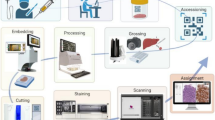Abstract
Purpose of Review
The digitization of pathology departments is underway, especially in larger institutions. The benefits are similar to those enjoyed by our radiologic colleagues, namely, efficient flow, intradepartmental communication, integration of clinical and laboratory findings with images, and the ability to consult with distant colleagues, all in real time. Meanwhile, there is an explosion of new imaging technology that allows us to go beyond traditional resolution limits and add visual overlays based upon molecular species and molecular interaction data. The purpose of this “hot topics” essay is to address and clarify these issues.
Recent Findings
New and emerging imaging modalities involve the transduction of spectral information into visual patterns, where the spectra may be derived from processes such as proton spin, Raman scatter, mass/charge ratios, and other physics-based probes rather than visible, fluorescent, and near infrared light. These collectively comprise computational imaging. Additionally, the massive data sets themselves require massive computation. Approaches to this challenge are presented as well.
Summary
This article explores the basic physical principles behind a number of the new technologies as examples of our current armamentarium as well as the methods used to analyze the resulting data in the context of a digitized pathology laboratory.
Similar content being viewed by others
References
Papers of particular interest, published recently, have been highlighted as: • Of importance
Hell SW, Wichmann J (1994) Breaking the diffraction resolution limit by stimulated emission: stimulated emission depletion fluorescence microscopy. Opp Lett 19:780–782
Klar TA, Jacobs S, Dyba M, Egner A, Hell SW (2000) Fluorescence microscopy with diffraction resolution barrier broken by stimulated emission. PNAS 97:8206–8210
• Fritzky L. and Lagunoff D (2013). Advanced methods in fluorescence microscopy, In “Biophotonics in pathology: pathology at the crossroads”, Cohen, S, editor, IOS Press, pp. 23–42. An excellent survey of fluorescence-based techniques that are at the forefront of high resolution imaging.
Cohen, S (2016). X-ray and terahertz imaging. Modality of the Month, ASIP Dig and Comp Path SIG http://www.asip.org/SIGs/DP/documents/5_MoMDCPSIG-TERAHERTZ.pdf.
Richards KS, Myring WJ (1990) X-ray microscopy. J Zool 221:683–687
Kihara H (2000) 3D imaging of X-ray microscopy. In: Ishizaka S (ed) In 2nd Internat. Symposium for Science of Firm. Scientific Publishers, Tokyo , pp 105–1141990
Schneider G, Gutmann P, Heim S et al (2010) 3D cellular ultrastructure resolved by Xray microscopy. Nat Methods 7:985–987
Huang D, Swanson EA, Schuman JS et al (1991) Optical coherence tomography. Science 254:1178–11919
Jung W and Boppart SA (2013). Optical coherence tomography for rapid tissue screening and directed histological sectioning. In “Biophotonics in pathology: pathology at the crossroads”, Cohen, S, editor,IOS Press, pp. 109-128 pp. 109–128.
Smith ZJ, Huser TR, and Wachsmann-Hogiu S (2013). Raman scattering in pathology, in “Biophotonics in pathology: pathology at the crossroads”, Cohen, S, editor, IOS Press, pp. 207–234.
Doerr AN (2015) Diamonds for MRI. Nat Methods 12:176–178
• Glenn DR, Lee K, Park H et al (2015) Single cell magnetic imaging using a quantum diamond microscope. Nat Methods 12(736–738):2015 Expands the state of the art for MRI Imaging
Lovchinsky I, Sushkov AO, Urbach E et al (2016) Nuclear magnetic resonance detection and spectroscopy of single proteins using quantum logic. Science 351:836–841
Schone C, Hofler H, Walch A (2013) MALDI mass imaging spectroscopy in cancer research: combining proteomic profiling and histological evaluation. Clin Biochem 46:539–545
Aichler M, Walch A (2015) MALDI imaging mass spectrometry: current frontiers and perspectives in pathology research and practice. Lab Investig 95:422–431
• Van de Plas R, Yang J, Spraggins J, Caparioli RM (2015) Image fusion of mass spectroscopy and microscopy: a multimodality paradigm for molecular tissue mapping. Nat Methods 12:366–372 Illustrates synergistic use of multiple modalities
Flach P (2015). Machine learning: the art and science of algorithms that make sense of data. Cambridge Univ. Press pp 157–192.
Hartshorn S. (2016). Machine Learning with random forests and decision trees, kindle.
Hassoun M (2003). Fundamentals of artificial neural networks, MIT Press pp.1–126.
Flach P (2015). Machine learning: the art and science of algorithms that make sense of data. Cambridge Univ. Press pp 207–211.
Horstmann C, Necaise R (2016) Python for everyone. J. Wiley and Sons, Inc, Hoboken, pp 1–244
• Rashid, T (2016) Make your own neural network, CreateSpace Publishers, 2016. Allows anyone to understand the principles of neural networks by actual example.
Toma T, Pantazi A, LeGallo M et al (2016) Stochastic phase-change neurons. Nature Nanotech 11:693–699
Wang TD, Van Dam J (2007) Optical biopsy: a new frontier in endoscopic detection and diagnosis. Clin Gastroint Hepatol 2:744–753
Fujimoto JG (2003) Optical coherence tomography for ultrahigh resolution in vivo imaging. Nature Biotech 21:1361–1367
Tanbakuchi AA, Rouse AR, Udovich JA et al (2009) Clinical confocal micro-laparoscope for real-time in vivo optical biopsies. J Biomed Opt 14:044030. doi:10.1117/1.3207139
Wang H, Lee AMD, Lui H, et al. (2013) A method for accurate in vivo micro-Raman spectroscopic measurements under guidance of advanced microscopy imaging. Nature: Scientific Reports art.no 1890, doi.10.1038/srep01890
Iftimia N, Ferguson RD, Mujat M, Patel AH et al (2013) Combined reflectance confocal microscopy/optical coherence tomography imaging for skin burn assessment. Biomed Opt Express 4(5):680–695
Author information
Authors and Affiliations
Corresponding author
Ethics declarations
Conflict of Interest
The author declares that he has no conflict of interest.
Human and Animal Rights and Informed Consent
This article does not contain any studies with human or animal subjects performed by any of the author.
Rights and permissions
About this article
Cite this article
Cohen, S. Digital and Computational Imaging in Pathology. Curr Pathobiol Rep 5, 93–99 (2017). https://doi.org/10.1007/s40139-017-0129-7
Published:
Issue Date:
DOI: https://doi.org/10.1007/s40139-017-0129-7




